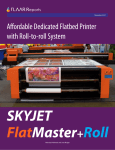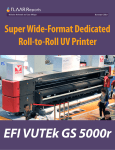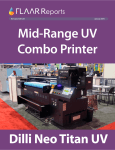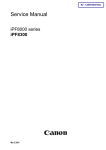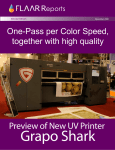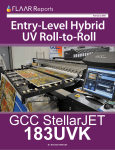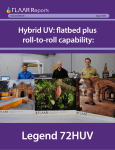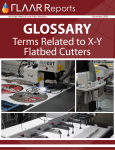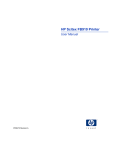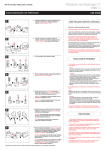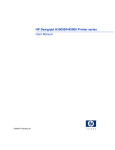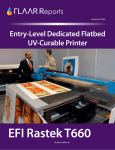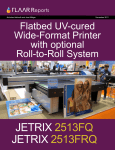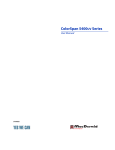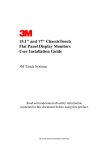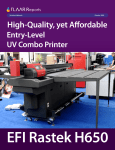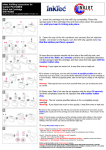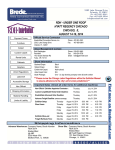Download Fast UV Flatbed Printer
Transcript
Fast UV Flatbed Printer Nicholas Hellmuth and Jose Melgar JETRIX 2030 FRK 1 October 2011 Fast UV Flatbed Printer JETRIX 2030 FRK Fast UV Flatbed Printer JETRIX 2030 FRK Contents Introduction1 THE BASICS 1 PURCHASING: DISTRIBUTORS & DEALERS 3 FEATURES OF THE PRINTER: Vacuum 4 STRUCTURE OF THE PRINTER: Media Transport Mechanism 5 LINING UP FLAT MATERIAL (to help it feed straight) 5 FLATBED ASPECTS (for dedicated flatbeds) 6 ROLL-FED6 Please Note This report has not been licensed to any printer manufacturer, distributor, dealer, sales rep, RIP company, media or ink company to distribute. So if you obtained this from any company, you have a pirated copy. Also, since this report is frequently updated, if you got your version from somewhere else, it may be an obsolete edition. FLAAR reports are being updated all year long, and our comment on that product may have been revised positively or negatively as we learned more about the product from end users. To obtain a legitimate copy, which you know is the complete report with nothing erased or changed, and hence a report with all the original description of pros and cons, please obtain your original and full report straight from www.large-format-printers.org . OPERATING THE PRINTER 7 CONSTRUCTION (BUILD QUALITY) 9 AESTHETICS10 SET-UP OF THE PRINTER: PRACTICAL CONSIDERATIONS 11 TECH SUPPORT & WARRANTY 11 PRINTHEAD TECHNOLOGY 12 PRINTHEAD DPI & Features 14 PRINTHEAD Positioning 15 SUBSTRATES15 SUBSTRATES, Materials, Applications, and Issues 16 SUBSTRATES: Cleaning, Priming, Preparation 18 WHAT IS THE INTENDED MARKET FOR THIS PRINTER? 18 INK18 INK Cost 19 INK: Supply System, Tubing, Filters, etc 20 THE UV CURING LAMPS 21 Your only assurance that you have a complete and authentic evaluation which describes all aspects of the product under consideration, benefits as well as deficiencies, is to obtain these reports directly from FLAAR, via RIP SOFTWARE & Printer Software 22 GENERAL CONSIDERATIONS 22 SUMMARY: Image Quality Issues: Banding 22 www.wide-format-printers.NET. Features that some printshops might like to see 23 Should you consider it? 23 Copyright 2011 Pros23 Acknowledgments23 Fast UV Flatbed Printer JETRIX 2030 FRK 1 Introduction The Jetrix 2030FRK is the most recent flatbed printer from the engineering firm Jetrix, a division of the experienced ink company, InkTec, based in Korea. It is a high-speed flatbed printer with an optional roll-to-roll system. Since we began taking notes on the first generation Jetrix flatbed printers at SGIA 2008, we have had the impression that these are solid machines that produce nice output. For example, Dr. Hellmuth visited recently a sign shop in Australia that is happy with his Jetrix flatbed. Although the model evaluated in this report has been exhibited twice in Europe already, it will undergo minor modifications, until its final release date in July or August 2011. Some of the specifications in this report could be changed in the near future. The first notes here were taken during FESPA 2011; further notes were taken in the factory several days after the huge Shanghai APPPEXPO trade show in China. The JETRIX 2030 FRK is the fast version of the JETRIX flatbed printers. Here, at FESPA Hamburg 2011. THE BASICS 1. Brand name, model? JETRIX 2030FRK; F = flatbed, R = roll-to-roll, K = Konica Minolta printheads. JETRIX 2030 FK, flatbed, Konica printheads, but no roll-fed option. 2. If there are two or three (or more) widths of this printer, what differences exist other than the width? So far there is only one version of this model but in two variations: with and without the roll-fed accessory. 3. What is the nature of the company? Is this company the manufacturer, distributor, or rebranding a machine made by someone else? InkTec, based in Korea is the manufacturing company. JETRIX is the brand name. Fast UV Flatbed Printer JETRIX 2030 FRK 2 4. What other printers are the same or similar chassis from this manufacturer or distributor? The 3015 is the earlier model. The earlier model prints across the wide axis. 5. Is this same model(s) rebranded and sold under other names? There are no rebranded JETRIX printers. 6. What other printers of other brands are comparable? In terms of speed, the recent Oce Arizona 550 XT, might be a comparable model. The Agfa :Jeti 2030 will also be a comparable model but the JETRIX is considerably more affordable than the Jeti printer. The SwissQprint is even closer to the JETRIX than is the Jeti; the Jeti models have always favored larger picoliter drop size, since these are billboard printers. The JETRIX can also do billboards but is more aimed at a printshop and clients that need the quality that a KonicaMinolta printhead can provide. 7. How does this model compare with comparable previous printers? As with all companies, the newer models of JETRIX are subtle improvements over the older models. Since the initial models were so sophisticated already, it is a challenge to do better, but the engineers enjoy providing additional capabilities. One of the engineers worked earlier at IP&I, one of the better UV-curing printer manufacturers of its time. 8. When and where was this model first introduced? The first prototype was shown at FESPA 2010. It was exhibited again in FESPA 2011, and it will be totally ready by late July 2011. The official release date will be in July or August. During June this model was not yet listed in the JETRIX website. The official release date was announced for a couple of months after FESPA 2011. JETRIX 2030FRK UV flatbed printer at FESPA Munich 2010. 9. Is this printer mature or still in alpha-stage or beta-stage? It is now coming out of beta-stage. When I visited the factory in July they had produced the first five machines. There are some features that are being added. But considering the quality of the earlier JETRIX models, this printer is expected to be similarly successful. 10. List price? There is no price yet because the printer will be shipped in later this month. Fast UV Flatbed Printer JETRIX 2030 FRK 3 11. What accessories are extra charge? Are these same or similar accessories included with other printers at no extra cost? The roll-to-roll system is optional. 12. Is an air suction system needed to be installed as a separate item, or is all the vacuum table or other vacuum requirements already included in the printer itself? When you visit the factory you can see all three vacuum pumps inside the printer. In fact when you visit the factory you can crawl inside or step inside the frame. PURCHASING: DISTRIBUTORS & DEALERS 13. Does the manufacturer have distributors in all continents? Or only a few dealers and missing key world areas? The Oldham Group is the distributor of the JETRIX printers in the United States. Complott Papier Union is one of the distributors in Germany, other is E.S.C.(Europa Siebdruck-Centrum). There are other 3 or 4 distributors in Europe. Anitech is the distributor in Australia. Keep in mind that it takes a very high quality for a printer made in Asia to have distributors in USA and in Europe. In general, printers made in Korea are good, and they have better reputation than most Chinese and Japanese printers. We know of some Chinese printers whose quality is very good, but these printers are not many. As years pass, Chinese manufacturers get more experience, and their printers are improving. This specific model is not yet available in the United States but it is highly possible that it is shown in upcoming trade shows. In any case, this printer is more suitable for the European market in terms of print sizes. Examples: Sun LLC has no major recognized dealer in North America and none in Latin America that I know of. DYSS lost their master distributor (each side tells a different story) and lost their US dealer also. Now DYSS has a completely different set of distributors. Dgen has switched distributors in the US as well. Teckwin has lost their US distributors and had to set up their own distribution company. But Durst tends to work mainly through their own company’s US office, so no one single setup is automatically bad, or good. 14. Where are distributors not present? Several European manufacturers and most Chinese, Taiwan, and Korean manufacturers lack distributors in the US. Having distributors in countries like The United States, Germany, Australia and England definitely speaks of the reputation of a printer. In other words, distributors in countries where the print quality standards are high, would have not accepted the JETRIX flatbed printers if these didn’t meet the standards for such markets. Fast UV Flatbed Printer JETRIX 2030 FRK 4 15. Are there issues between the distributors and the manufacturer? Can you rely on the distributor today being willing to stay together with the manufacturer, or jump ship and potentially leave an end-user somewhat abandoned when there may not be a new distributor? There are several manufacturers who are well known in the industry for having issues with distributors. This is no reason that their printers are faulty as a result, but if the distributor abandons the manufacturer because of squabbles with the owner of the manufacturing company, then an end-user may be stuck with no one to provide warranty service or after-warranty service at a fair price. FEATURES OF THE PRINTER: Vacuum 16. Is there a vacuum function? Yes. Flatbed media is held down by a vacuum system, as in most flatbed printers. 17. Is the vacuum created by simple fans, or by an air pump? Vacuum is created by three air pumps. The advantage of the JETRIX printers compared to other entry-level flatbed printers is that the vacuum pumps are integrated within the main chassis. In other words, you don’t need extra space to accommodate the air pumps. Air pumps inside the body of the printer could be taken for granted, but the quantity of UV flatbed printers with the vacuum pumps outside the printer at D-PES Dongguan 2011 trade show was impressive. These are the small details that little by little incline the balance towards a printer compared to other brands. 18. In how many sections? There is a vacuum pump per section. So the flatbed table has three sections. Photograph taken during FLAAR’s visit to JETRIX factory. The three vacuum pumps are visible through the printer’s framework. Most of the electronic boards are located at the left side of the printer, including the electronics of the vacuum system. Fast UV Flatbed Printer JETRIX 2030 FRK 5 STRUCTURE OF THE PRINTER: Media Transport Mechanism & Media Path 19. Is this a dedicated flatbed with no roll-to-roll capability? Or is this a true flatbed or just add-on feeder platforms at front and back? This is a high-speed dedicated flatbed but as mentioned earlier, there is an optional roll-to-roll system available. Just realize that the best machine to print on flat material is a dedicated flatbed and the best printer to print on roll-fed is a dedicated roll-to-roll. The advantage of a combo printer is that it can print on both flat and rigid and roll-fed material. But no joint-use printer can print on all materials perfectly: irrespective whether it is a $80,000 entry level or $300,000 VUTEk or other brand. 20. Was this printer made originally as a UV-curable ink printer, or is it retrofitted with UV-curing? If retrofitted, what was the original brand or model? JETRIX printers are made from the ground up to be UV printers. JETRIX as a brand name was born in the UV era, so there is no solvent background. We saw the first JETRIX at ISA or SGIA 2008. At FESPA Hamburg 2011 the model was exhibited with the optional roll system, therefore, the printer is labeled as the JETRIX 2030FRK. LINING UP FLAT MATERIAL (to help it feed straight) 21. How is rigid media fed? Being a dedicated flatbed, rigid media is fed manually. And being a dedicated flatbed is one of the reasons you can’t do overnight printing with this model. In fact, an HP Sales Manager mentioned that although their gigantic HP Scitex TJ6500 can do overnight printing, it is not advisable to abandon any printer for more than one hour, no matter how independent it is. 22. Can you be feeding or aligning new material at one side of the printer while the previous job is still printing out the other side? In theory you can. But it is not very practical if you have to activate all vacuum areas when having smaller pieces of media. 23. Is two-sided printing realistic? Is there a special mechanism for registering the position of the image on the second side? Yes, it is possible. Fast UV Flatbed Printer JETRIX 2030 FRK 6 FLATBED ASPECTS (for dedicated flatbeds) 24. Does the table move? Or only the gantry above it? The table is stationary; the gantry moves. The movement of the gantry and the printhead carriage is being read by an encoder band, which sends information of position to the software. There is an encoder band at each side of the flatbed table, and another in the gantry. As in most flatbed printers, the table is stationary and the gantry moves in “Y” axis, while the printhead carriage travels from right to left. ROLL-FED 25. How is media held flat? Vacuum table? Pinch rollers? There is a vacuum system. 26. How is the roll held at the feeding position? On a spindle? On a saddle? The rolls are held on a spindle. The mechanism is intelligently integrated at the front, unlike some other flatbed printer models like the Mimaki JFX-1631 or the SwissQprint Oryx and Impala, where the roll-to-roll system is designed to load at the back, media is passed all along the flatbed table, and taken up at the front. This design is not very practical because the media path is longer, exposing the workflow to more issues, such as media skewing, or media wasting. A saddle is formed of two rolls with a slight space between them. You rest your roll of substrate on the saddle created by the two adjacent rolls. You don’t need to run a spindle through the roll. You don’t need to fumble loading the end of the spindle into two holders (one at each end). Loading a saddle is quicker as a result. But a saddle is primarily used on heavy-duty industrial printers 3.2 meters or wider where the weight of a roll may cause a spindle to sag. Plus, it’s a headache to thread a spindle through a 5-meter long core. The roll-to-roll mechanism is integrated at the front. We believe this is a better design than the flatbed printers in which you have to load the roll at the back, pass it through the flatbed table and take it up at the front. Fast UV Flatbed Printer JETRIX 2030 FRK 7 27. Is there an air (pressure) core system? Air core spindles tend to be used only on grand-format printers costing over a quarter of a million dollars. 28. Is the feeding area for roll-fed material physically attached to the printer or is it out in front and not attached (as on the GRAPO Octopus). The roll mechanism is totally attached to the flatbed table. Skew is a common downside of a conveyor belt transport system. The reason is because the belts are flexible. To some degree the flexibility is inherent, since most belts are woven material. The heat will also cause the belt to become flexible. These aspects are not specific to Grapo but are one of the pros and cons of the combo transport belt system. As a result Grapo learned that it is actually more practical to have the media roll out in front of the printer rather than the roll-fed mechanism being bolted to the front of the printer. If the roll-fed system is rigidly affixed to the front of the printer, and has no manner of fine-tuning the position of the feeding rollers, after many months the rolls may not be 1000% parallel to the transport belt. By having the roll-fed mechanism free, and movable, you can allow the paper to feed itself in a parallel manner. Plus, the movable roll-fed unit allows you easily to move your media around and change media (if you have a second roll-fed unit you can simply switch the entire unit rather than having to off-load and on-load a different kind of substrate. The roll system is totally attached to the chassis of the printer. OPERATING THE PRINTER 29. Can the operator manage print jobs via the Internet with this printer? Not normally. 30. Is the printer user friendly? Yes. The JETRIX flatbed printers are well designed. Besides as you will read further on, the JETRIX flatbed printers use only mainstream RIPs. Fast UV Flatbed Printer JETRIX 2030 FRK 31. Do you get an LCD screen in the printer or other real computer monitor? How big is the screen or monitor? Yes, you get a real computer monitor. 32. Is the position of the LCD screen or monitor user-adaptable? Yes the base of the monitor and keyword is totally user-adaptable. 33. Where does the computer keyboard sit? The monitor and keyboard sit on a base held at the end of a movable arm, at the right side. 34. Can the keyboard be moved or is it fixed into the structure of the printer? The whole arm on which the monitor rests can be swiveled and the vertical position can also be changed. The printer comes with a full computer located at the right corner. 35. Is there a ledge or other space where the operator can park tools, cleaning liquids, iPod or other accessories? Increasingly too many UV printers have slick exterior skins. They look like a designer style, but are impractical because there are no ledges for storing cleaning fluid, wipes, Coca-Cola cans or coffee mugs, etc. 36. Where does the operator stand or sit? As you can see, the operator sits at the right. 37. What controls are on either end? There are no actual controls at neither side. 38. Is a foot pedal included (for operating aspects of the printer)? I have not seen a foot pedal on any JETRIX flatbed so far. 39. Can you do unattended printing? For how long? How about overnight? In theory you can, but being a flatbed printer, it is not practical to do unattended printer because you would need to load substrates onto the printer constantly. 40. How many operators or operator assistants does this printer require? One is enough. Rotating Monitor Arm The arm that holds the monitor and keyboard is a sophisticated structure whose position can be adjusted vertically and horizontally. 8 Fast UV Flatbed Printer JETRIX 2030 FRK 9 41. Is there a pole with beacon lights? No. These models are not equipped with a pole light, but this is not a major disadvantage. Dilli was among the first to use a vertical pole with beacon lights. One person said that DuPont’s UV printer from RTZ (Flora) was the first of all. Most other printers do not have such a beacon. Presence of a beacon is not a major plus point; absence of a beacon is not a significant minus point. The GCC StellarJET 183UVK also has a pole with beacon lights. CONSTRUCTION (BUILD QUALITY) 42. What is the solid-ness of the construction of the outer body? Is it plastic? Metal? Heavy gauge? The printers are very sturdy. There is no vibration as the printhead carriage moves. 43. Is there both a front opening for the hood and a back opening? No. The printer is a totally open system. Enclosed printers tend to be in the high-end price range, for example, EFI VUTEk and Durst. The sturdy framework of the 2030 FRK model at JETRIX factory, in Korea. Fast UV Flatbed Printer JETRIX 2030 FRK 10 Dr. Hellmuth inspecting the structure of the JETRIX 2030 FRK inside out at the factory. When a manufacturer pays attention even to the parts that are not seen by the end user, you can tell the quality of a printer is reliable. AESTHETICS 44. How would you describe the design of the printer? The JETRIX flatbed printers are very attractive. This specific model is a bit more “industrial” than the other models, so it looks nice but especially sturdy. 45. Can you easily distinguish which is the “front” and which is the “back’? Yes it is easy to tell. All the operations and the loading of the roll media is done at the front. I call the front the area where the LCD and operator panel(s) are situated. This usually means that the other side is where you feed the material in. I call that the back. But many printer companies call the feeding area the front. It makes no difference as long as you define what you mean in advance. The design is attractive but not as trendy as the other JETRIX flatbed printers. This model is a little bit less focused on appearance and more focused on production. Some UV-curable printers have a moveable control computer that can be situated at one end, or at the feeding area (whichever location the operator prefers). But the standard arrangement is that the LCD and keyboard are on the output side. I call this the front. Fast UV Flatbed Printer JETRIX 2030 FRK 11 SET-UP OF THE PRINTER: PRACTICAL CONSIDERATIONS 46. What is the delivery time, between the time I order the printer and it is delivered? The printer takes 4 weeks for building, and around 2 weeks for shipping, depending on where you are. TECH SUPPORT & WARRANTY 47. What is the original warranty period? The warranty is one year, and it includes parts and labor. The normal original warranty period is one year but Gerber has had a special offer of “second year free if you buy before such-andsuch a date. 48. Is there an extended hardware warranty? What price? Yes. An external tech support provider says there is an extended warranty available for year 2 onwards. 49. Who does repairs? Dealer, manufacturer, distributor, or third-party? For example, Total Graphics Solutions is a JETRIX certified service provider based in the UK, but with the ability to cover other European countries as required. This company is contracted to provide 24-hour engineering support to JETRIX printers customers. Service managers and engineers from around the world being trained at JETRIX manufacturing plant, July 2011. Fast UV Flatbed Printer JETRIX 2030 FRK 12 PRINTHEAD TECHNOLOGY 50. Which brand printhead is used? Konica Minolta 1024. This is one of the few significative differences between the JETRIX 2030 FRK and all other JETRIX models, which use Spectra heads. Most UV printers made in the US, Japan, and Europe use Spectra, Ricoh, or KonicaMinolta heads. VUTEk is one of the few that uses Seiko printheads. It is reported that one downside of Seiko heads is that they must spit (which waste expensive ink). Most Rho printers do not have to spit except for white ink. 51. Is the printhead identified in the spec sheet brochure by brand or also by model, or not at all? The brochure does not mention printheads. However, the printer model is JETRIX 2030 FRK. The last “K” stands for Konica Minolta. This is common in other printers using Konica-Minolta heads. For example the GCC K72UV, The Grapo Manta K720W 52. Is this a printhead adapted from solvent ink or a new design made especially for UV ink chemistry? This particular model of head is relatively new (compared to the older 512 model) and has two versions, one especially designed for UV ink, and one especially for solvent ink. 53. How many other printers utilize the same printhead? Have they shown any problems? These are some of the printers using the Konica Minolta 1024 printheads: • Agfa :Anapurna M2 • Agfa :Anapurna M1600 • Agfa :Anapurna M2050 • SwissQPrint Oryx As you can see, this model of printhead is used in known and respected UV printer brands. The Konica Minolta 1024 printhead model is relatively new. However, it has been chosen for different UV printers already. Fast UV Flatbed Printer JETRIX 2030 FRK 13 54. What are the benefits of this printhead? The Konica Minolta 512 head has a print swath of 36 mm, whereas the 1024 model has a print swath of 72 mm. By covering twice the space in one pass, the printer using the KM 1024 model should be faster than the printer using KM 512. In addition, the KM 1024 has twice the number of active nozzles of the KM 512. The other similar printhead is the XAAR 1001 head. One of the major features of this model, is the integrated recirculation system (not only for white, but for all colors). By having the ink in constant movement, you don’t need to purge as much. We have not determined if the KM 1024 has a similar feature, but will update our comments as soon as we find out. 55. How many nozzles per printhead? Each printhead has two lines of 512 nozzles, which makes a total of 1024 nozzles per head. In this photograph taken at the factory in July 2011, you see two rows of printheads: the eight printheads at the left are closer than the eight printheads at the right. 56. How many printheads per color? Depends on the ink configuration requested. You can have up to 12 printheads for colors (4 heads per color); 2 for white ink and 2 for primer. 57. How many total number of printheads? It is up to you. You can have from 6 up to 16 printheads. 58. What is the position of the white printheads relative to the rest? All printheads are aligned. Fast UV Flatbed Printer JETRIX 2030 FRK 14 At FESPA Hamburg 2011 the JETRIX 2030FRK was using a total of 16 printheads to produce output. PRINTHEAD DPI & Features 59. What is the drop size in picoliters? 14pl. 60. Is there variable droplet capability? Yes. This model has 8 levels grayscale, but the printhead literature does not list the variation in drop size. 61. Does the software use passes or modes to describe quality levels? The printer has three print modes: Print Mode Speed Draft 60 sqm/hr Quality 40 sqm/hr Fine-Art 20 sqm/hr In general, in most UV printers the output in draft mode is not something you can sell. We would have to determine the quality of the JETRIX FRK in a further evaluation, ideally in the factory or a sign shop. FLAAR prefers to use consistent terms that are standardized for all printers so that printshop owners, managers and printer operators have a fair chance of comparing speed vs quality. By not identifying the actual passes, or by defining pass in an atypical manner, this results, in effect, in hiding the reality of speed vs quality. Thus we commend those companies that keep to, or return to, the traditional usage of the term pass(es). Fast UV Flatbed Printer JETRIX 2030 FRK 15 Increasingly most printer companies are not listing the passes that their printers run back and forth. The definition of a pass is not consistent in any event: FLAAR defines a single pass as the movement of the printer carriage, while jetting ink, from one side to the other. There is a difference between “single pass” and “one pass” but that needs an entire article (one pass means a page-width row of non-moving printheads). Mutoh describes one pass as a complete back-and-forth movement (FLAAR defines that as two passes). Most printer manufacturers would rather avoid having to state clearly how many actual passes it takes to achieve specific quality levels. So they create “modes” that are a combination of passes and possibly other features that result in a specific quality level. PRINTHEAD Positioning 62. What is the position of the printheads relative to the media? Above, jetting down (the common position) or alongside, jetting horizontally (rare)? Above, jetting down. 63. Are the printheads at an angle to the movement of the carriage, or at 90-degrees? Printheads are at 90-degrees relative to the media. 64. How wide is the path of a printhead, or the carriage full, for a single pass (one movement from right to left, or left to right (but not both together)? The printheads cover a swath of 72mm. 65. How complex is the procedure to align the printheads? When you add a new head, how long does it take to align it? The HP spec sheet is helpful in alerting you to the reality of aligning their X2 MEMS printhead when you need to replace a failed head with a new one: 45 minutes. Even if this honest estimate was not provided in the spec sheet, it would be ascertainable sooner or later anyway. I commend HP for being ethical in listing this aspect of maintenance. SUBSTRATES 66. What sizes of material can be printed on? 2050 x 3060 mm (6.7 x 10 feet). 67. What about edge-to-edge printing (borderless)? Yes, it is possible. 68. What thickness can this printer handle? 6 cm. (5.5 inches). The Konica Minolta 1024 heads produce a swath of 72mm. which is twice the length covered by the previous printhead model, the KM 512. Fast UV Flatbed Printer JETRIX 2030 FRK 16 In spite of being a “speed” printer, the output produced at FESPA Hamburg 2011 was impressive. The maximum media size is 6.7 x 10 feet, but we have not determined yet whether the JETRIX 2030 FRK can print edge-to-edge at the maximum media width. SUBSTRATES, Materials, Applications, and Issues 69. What materials does the manufacturer list? Foamboard, coroplast, acrylic, sintra, styrene, gatorboard, dibond and other aluminum composites, glass, mirrors are some of the rigid materials. Vinyl, PVC banner, tarpaulin, mesh, one-way vision, blockout are only some of the roll materials. 70. Heat concerns: will the heat generated by the UV curing lamps cause adverse effects to some delicate forms of heatsensitive media? Which materials might curl, distort or discolor from the heat? Heat sensitive materials for mercury arc UV lamps would include polyethylene, polypropylene, shrink-wrap, very thin and thermal sensitive papers, plastic coated cartons, PVC and aluminum foil (www.dotprint.com/fgen/prod1297.htm). Oce lists several other common signage materials as sensitive to the heat of UV lamps. For these reasons we have a separate FLAAR Report on applications and materials. Heat can build up when the printhead carriage hovers over a small area to print a narrow job. Heat can build up inside the printer as materials (especially metal) absorb heat and hold it (and then radiate it out for a long time). So heat is not only an issue from the obvious and immediate heat of the UV lamps. Residual heat can be an issue as well. Fast UV Flatbed Printer JETRIX 2030 FRK 17 You can in effect lower the heat that reaches the material by raising the entire printhead carriage. However this results in noticeably less quality (because the ink is flying through the air a longer distance while the material is moving away from it). You can also set the printhead carriage to move further away from the printing area at the end of each pass (in those cases that the media is less than the maximum and in those cases where these settings are facilitated by the printer design and firmware). One way to dissipate heat is to have good ventilation drawing the hot air up and out of the enclosed printer. There are two exhaust tubes at the top for this purpose. These are not only to suck out the odor and ink mist, but to remove some of the heat too. 71. What about build up of static electricity? What kind of materials cause this? Do some materials generate static electricity which cause the media to attract ink in areas not supposed to be printed on. How is it manifested? You do need to be aware of how to prevent static electricity build up: • No carpets or rugs on the floor. Indeed you should consider anti-static tiles or carpet. • Use a humidifier during winter months to avoid dryness • Learn which media are susceptible to gathering a static charge. • Consider a printer that has specific anti-static features: Nice sample being printed on banner at FESPA Hamburg 2011. • Grounding • Static bar(s). Most printer reps suggest this is more an environmental issue than a printer or ink issue. They say you can’t have carpet and you must maintain a high humidity. They admit that the static electricity situation varies depending on each site’s situation. Nonetheless, some UV printers already have anti-static systems carefully built into their printers. When these work it documents that the investment is well spent. However if the low price of your printer is in part because there is no on-board static system, and if you indeed have a static issue, the natural question is why, since this is such a well-known issue, did your brand not have an anti-static system or if so, why does it not work satisfactorily. One economical way to get rid of some static is to use a fabric softener – Downy-for example, which you can get from the supermarket. But be sure to learn which materials need anti-static treatment. No sense wasting time with those materials which do not have a static issue. And be aware that the amount of cleaning liquid you put onto a material can cause after-effects when that same material is heated by the UV lamps. 72. What happens in very dry weather (low humidity), especially in winter with central heating? During dry periods (with low humidity) static problems may increase. With a high static charge (such as with PVC materials), the ink is attracted to charged areas of the material. This results in overspray (ink laydown in unintended areas). Dust can be a problem in places and seasons with low humidity. This is one of several reasons why you should have humidity control in your printshop, to allow maintaining proper humidity level for optimum performance of your printer. Fast UV Flatbed Printer JETRIX 2030 FRK 18 Static control is as much an issue with your printshop environment as it is with the pros and cons of the individual printer, though some machines handle static better than others. SUBSTRATES: Cleaning, Priming, Preparation 73. Do you have to brush off or otherwise clean each sheet of incoming material by hand before you print on it? For flat rigid materials generally yes. In the specifications for handling media, the User’s Manual states that dust or contaminated particles on the material cause a significant reduction of the print quality and ink adherance, so you should print only after being cleaned and dusted. The JETRIX 2030 FRK comes with an air gun to clean substrates. The The need to clean incoming materials is typical of any printer. Some materials have more detritus or dust or issues than other materials. And some suppliers offer better materials than others. I rarely see any printer operator attempting to clean rollfed materials. WHAT IS THE INTENDED MARKET FOR THIS PRINTER? 74. What is the market that the manufacturer has designed this printer for? This printer is mainly designed for the signage market but also for the glass industry. This printer is also adequate for the printed metal and acrylic industries. The same image than the sample in the previous page, but this time printed on Plexiglas as a backlit application. INK 75. Is there a special ink for flexible material, and another ink for rigid material? What other inksets are available? Is there any choice in inks? It is the same ink for rigid and roll materials. According to a marketing manager from another company, having different inks for rigid and flexible materials in a printer that handles both types of materials could mean a loss of up to 1½ liter of ink in every ink change. 76. How many colors are used to produce output - four, six, or eight? CMYK are standard. Lc, lm, W and Primer are optional. 77. What is shelf life of the ink (CMYK)? Shelf life of the ink depends on storage temperature, plus on how honest the company was that delivered the ink. If the company bought too much ink, and could not sell it fast enough, they might be tempted to back date the shelf life. Fast UV Flatbed Printer JETRIX 2030 FRK 19 78. What company makes the inks? Choices include DuPont (who could be considered as cheating by claiming the ink is theirs; it probably comes from Triangle), Jetrion (now InkWare/VUTEk), Hexion (now owned by Collins), Sericol, Sun, Triangle, KonicaMinolta, Toyo, AT Inks and several others. InkTec makes the inks. It started as an ink company that expanded towards developing printers. 79. Does the printer manufacturer have its own ink chemists on staff? Durst, HP and comparable large printer manufacturers have their own ink chemists (even when they don’t necessarily manufacture their own ink). But even when a company owns their own ink factory, sometimes they also rebrand the ink from completely different ink companies when they need an ink that they themselves do not yet make. The ink delivery system is carefully engineered specifically to handle UV-curable ink. INK Cost 80. Does the refill container of ink come in cartridge, bottles or bulk? How large are the ink containers for this replacement ink? Ink comes in 1 liter bottles. Ink tends to come either in bottles (where you pour the ink into the ink container on the printer) or containers that are themselves the ink container: you take the old one out; throw it away; and place the new container in its place. Cartridges tend to only be used in printers with Epson printheads. No currently functioning UV printer other than the narrow format Roland LEC-300 uses Epson printheads: one Eastech printer tried, but it is not widely used. 81. How can you see the remaining ink level? ? Do you have to ask to see the ink mode, or is the ink status available at all times? You can see the current ink level per color in the monitor. Fast UV Flatbed Printer JETRIX 2030 FRK 20 The remaining ink level can be checked in the monitor. INK: Supply System, Tubing, Filters, etc 82. Where are the printer’s ink containers located? Front, back, or end? Up on top or lower down? The ink containers are located at the back, in the rear cabinet. The refill tanks, located near the main tanks inside the printer’s structure. When the printer is turned off, all power in the printer is obviously stopped, except 24v, which are needed to maintain the negative pressure for the subtanks. The User’s Manual provides detailed explanations on how to handle ink tubes, replace filters, etc. Fast UV Flatbed Printer JETRIX 2030 FRK 21 THE UV CURING LAMPS 83. How many different sets of lamps are there? Is there pinning first and then curing later? 95% of UV-curable printers have only curing UV lamps. Only the Inca Spyder 150 and a few other innovative machines have a pinning lamp before the curing lamp. 84. What technology is used in curing lamps: microwave, continuous (mercury arc), LED, or flash (pulsed Xenon)? Mercury arc lamps. Virtually all UV printers use mercury arc UV lamps. Only NUR and a few others use microwave UV lamps. Pulsed Xenon lamps have failed the few times they were tried (an early VUTEk UV printer circa 2000-2001; a cheap Oce Arizona 60uv printer). LED lamps are now being tried in several UV printers, such as by Sun LLC (in Russia), Mimaki, and Roland. The Gerber Solara ion uses a rare type of long relatively cool UV lamp that is not used by any other wide-format inkjet printer manufacturer. 85. How many lamps does the printer use? Most normal UV printers have two lamps, one for each direction of printing. Some cheap Chinese printers use only one lamp. Mimaki uses one lamp on several of their narrow-format UV printers to avoid the lawnmower effect that is caused by bi-directional printing (bi-directional print requires two lamps, one for each direction of ink laydown by the printer carriage). The Agfa :Anapurna 100 (a printer that was never finished due to being too complex), and its recent replacement, the :Anapurna XLS, have three sets of lamps: all curing, not for pinning. The Lüscher JetPrint, due to its über-dimensional size, may also have needed more than two lamps (whatever it had did not function fully adequately). 86. How many watts are the lamps? 100 Watts/cm, according to the lamp specs. 87. What brand of lamp is used? Integration Technology Sub Zero UV lamps. The NUR Expedio Inspiration uses Nordson microwave technology. Gandinnovations uses Dr Honle, but these are traditional mercury arc, not microwave. Mid-range and entry-level UV-curable printers tend to use UV mercury arc UV lamps from Integration Technology. Because the JETRIX 2030FRK prints at higher speeds compared to the other JETRIX flatbed printers, this model requires a stronger UV lamp model. This is the Integration Technology SubZero 170, which has twice the arc length (UV light coverage) compared to the UV lamps used in other JETRIX models. Fast UV Flatbed Printer JETRIX 2030 FRK 22 RIP SOFTWARE & Printer Software 88. Which RIPs are featured? Caldera and Onyx. When several RIPs are available for a printer, Caldera tends to be the most expensive option. GENERAL CONSIDERATIONS 89. How many printers of this model are in use; in the USA; in the rest of the world? There are no printers sold yet because the printer is not yet on sale. Again, the printer will be officially launched in July or August 2011. It is crucial for a printshop owner, who is making their short list of which printers to consider buying, to know how many printers of each brand have been sold. SUMMARY: Image Quality Issues: Banding 90. Is there banding in areas of solid black? No noticeable banding at FESPA 2011. Between 50% to 75% of all UV printers at a typical trade show exhibit at least bi-directional handing. Some printer booths cheat and set their printer on uni-directional mode. Normally this gets rid of bi-directional banding. But you may also have banding from a nozzle being out. Or there may be banding from inaccurate feeding of the material or movement of the gantry between passes. 91. What causes banding in this particular system? See above; but there may be other causes. 92. How can banding be avoided? More passes tend to get rid of banding on almost any and all inkjet printers. Of course it helps if the machine is precision engineered so you don’t get much banding at four passes and above. Banding at two passes is normal. You can eliminate pass-overlap banding by using an interweaving technique (which Mutoh developed and now Roland and others have copied). No banding was perceived in the samples printed at FESPA Hamburg 2011. Fast UV Flatbed Printer JETRIX 2030 FRK 23 Conclusions The JETRIX 2030 FRK is a reliable flatbed printer which FLAAR classifies as a “dual structure” printer (a flatbed printer that has roll-toroll capabilities). Even when its major selling point is the speed, the quality shown at FESPA 2011 was remarkable. In other words, InkTec, the manufacturing company is not sacrificing the print quality to favor speed. As you read several times throughout this report, there is no official price yet, because the printer was not being sold by the time this first version of the report was being written. The printer will undergo minor improvements in software before it is ready to be shipped. According to JETRIX personnel, this model will begin to be sold in Europe in July 2011. As for America, it is expected that the printer is ready by SGIA 2011 (October). So this report will be updated with notes of upcoming trade shows. Pros The fact that there are at least two distributors in Germany, one in Australia, and one in the United States, gives you an idea that several dealer companies trust this equipment. Comments such as the above are how you tell the difference between a pseudo-review by a commercial PR agency (which would never dare to list something which should be added) and an evaluation by FLAAR Reports. Our goal is to help the print shop owner, manager and printer operator, as well as to suggest to the manufacturer one or two features to consider. Features that some printshops might like to see Should you consider it? This is a true flatbed. It is not a combo-belt system. Being a true flatbed is the first benefit that results in print quality. Since the printer is new, we are having a challenge finding anything negative about this printer. However our role is not as a PR agency; our role is an evaluator. Thus it is essential that we comment about the actual printer as you will face when it arrives in your printshop to begin work. Our estimate is that, based on the experience of JETRIX ink team and design engineers, that this will be a good machine for printing diverse applications. However there are one or two features we would like to see added in the future One would be an alignment system for the table, either pins, or a raised edge. Or perhaps a line where you could add a raised edge yourself if you wish this option. We would also like to see a manner of shielding the bright UVcured lamps when you are standing at the edge of the printer. Presently the UV-curing lamps are well shielded from the front. The JETRIX shielding on the front is significantly better than on the SwissQPrint (where the light streams out of the openings in the screen; from some angles piercing bright). But it would be nice if an option could be offered for shielding from when the operator or plant manager is looking at the machine from the side, and can see over the shielding frame. Acknowledgments FLAAR thanks Mr. Peter Kim, Vice-President of InkTec, Steve Draper, Director of Total Graphics Solutions, and the JETRIX staff for their patient help to answer the basic questions in the booth of JETRIX at FESPA 2011 so we could issue this initial report. If you need a low-budget flatbed, you have several options: get a low-cost grit-roller printer that is called a flatbed but is really a modified solvent-based roll-to-roll printer. Printshops with experience will generally admit that grit rollers are inadequate to move a diverse range of thick or rigid materials. Even Colorspan-HP stopped trying to make grit-roller flatbeds. Even 90% of the Chinese UV printer manufacturers have stopped offering grit-roller flatbeds. Only Neolt, Mimaki, and Roland still try to offer grit-rollers under pinch rollers for moving thick and rigid materials. Second option is to buy an entry-level combo-belt printer. EFI Rastek offers one (Rastek H652). HP offers another, the HP Scitex FB500 and FB700 (HP improvements based on what ColorSpan developed several years before). Third option is to purchase a Chinese-made dedicated flatbed printer: Sky Air-Ship is the model we know the best. Fourth option is to consider the Oce Arizona (but be sure to avoid a used Arizona 250; end-users report that some of these had endless problems, especially with the finicky ToshibaTec printheads). Fifth option is to buy the SwissQprint, Made-in-Switzerland. Or you can save enough money to buy yourself or your spouse (or your college-bound son or daughter) a new car, by considering one of the JETRIX dedicated flatbed printers. First issued October 2011 Copyright FLAAR 2011 Fast UV Flatbed Printer JETRIX 2030 FRK These are some of the recent FLAAR Reports on UV for 2010 - 2011 There are alos even more available from 2009 (some of which are still pertinent). These are some recent reports on interesting UV flatbed printers Based on notes gathered at trade shows, actual sign shops and the very manufacturing plants. 24 Fast UV Flatbed Printer JETRIX 2030 FRK These are some of the TRENDS level of FLAAR Reports on UV for 2010 - 2011 There are alos even more available from 2009 (some of which are still pertinent). 25



























